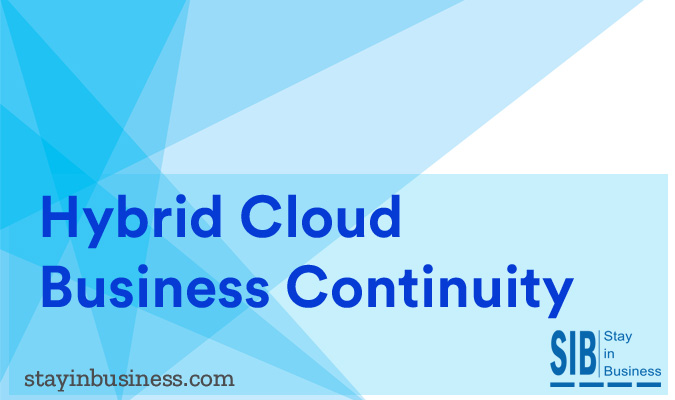
HYBRID CLOUD BUSINESS CONTINUITY
The hybrid cloud combines the advantages of a Private and Public Cloud. Organizations using a Hybrid Cloud use the Private portion of the cloud for mission-critical applications and for less critical applications they use the Public Cloud. The advantage of using such a combination is the Private Cloud gives enhanced security whereas the Public Cloud lowers the price of the Business Continuity solution.
With so many data breaches taking place, protecting data is the prime concern of IT Managers. For BC, the DR procedure should be based in the Private Cloud. Since a Private Cloud has only one client using this service, data is highly secure. The Private Cloud service provider also encrypts data and along with Passwords etc. a highly trustworthy security scenario can be created. Data can be transferred from behind the firewall of the client’s server directly to the Private Cloud, which give another layer of added security.
Since the Private Cloud is a sort of exclusive club, the price structure for such services will be on the higher side. This being the case, to reduce expenses, non-critical applications are generally not hosted in such a costly environment. Such non-critical application and data can be stored on the Public Cloud. While the Public Cloud may be less secure, but that does not mean that anyone can hack into the system easily. The Public Cloud too will have access controls and most cloud service providers use a two stage access system for authentication of the user.
Disaster Recovery and Business Continuity procedures being extremely critical in nature must be located in the Private Cloud. This will ensure that when a disaster strikes and production stops, the Recover Time Objective and Recovery Point Objective metrics can be met. It will be easy for IT Managers to restore production and reload the servers, install security patches etc. by accessing the DR/BC procedures located in the Private Cloud. Even if there is a sudden spike in traffic during the recovery phase, the Private Cloud will be able to handle the data transfer volume. It is a good part of BC policy to incorporate redundancy into the system ab initio.
Since the organization stores the non critical applications and data in the Public Cloud, even if there is a time lag during recovery, it will not have a major deleterious effect. Even the Public Cloud will have easy scalability and any spike in data transfer can be easily handled. In both instances, IT Managers should ensure sufficient bandwidth capacity plus some extra is available at all times.
Since the competition in the IT field is very high, cost effectiveness is what organizations want. When replicating in a hybrid system, costs are lowered but not at the cost of security. The organization does not need to maintain an off-site production center, which may sit idle for even years without being put to use. When the DR/BC Plan is based on a Hybrid Cloud system, even if the physical infrastructure of the organization is destroyed, they can access the virtual desktop in the cloud and continue with production.
The Hybrid Cloud solution for Business Continuity is a win-win situation for any organization, big or small. It gives the essence of what an IT Manager is looking for security of data at the lowest possible cost.
Disasters
[carousel id=’1780′ items=’4′ items_desktop=’3′ margin_right=’5′ navigation=’false’] [item img_link=”https://www.stayinbusiness.com/wp-content/uploads/2016/02/Chemical-Spills-Discharges.jpg” href=”https://www.stayinbusiness.com/resource/disaster-recovery/chemical-spills-and-discharges/”][item img_link=”https://www.stayinbusiness.com/wp-content/uploads/2016/02/Riots-Public-Disturbances.jpg” href=”https://www.stayinbusiness.com/resource/disaster-recovery/riots-and-public-disturbances/”][item img_link=”https://www.stayinbusiness.com/wp-content/uploads/2016/02/Terrorism.jpg” href=”https://www.stayinbusiness.com/resource/disaster-recovery/terrorism/”] [item img_link=”https://www.stayinbusiness.com/wp-content/uploads/2016/02/worst-product-recall.jpg” href=”https://www.stayinbusiness.com/resource/disaster-recovery/product-recall/”] [/carousel]

